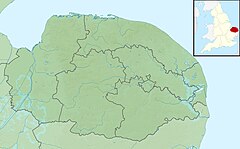| Panford Beck | |
|---|---|
 The headwaters of Panford Beck | |
Panford Beck within Breckland | |
| Location | |
| Country | England |
| State | Norfolk |
| Region | East of England |
| District | Breckland |
| Physical characteristics | |
| Source | 1 mile north east of the village of Brisley |
| Mouth | Merges with the Black Water |
• coordinates | 52°44′8.8″N0°54′34.6″E / 52.735778°N 0.909611°E |
| Length | 2.5 mi (4.0 km) |
Panford Beck is a minor watercourse that is entirely in the county of Norfolk, eastern England. [1] This small short beck rises within the Parish of North Elmham a mile north east of the village of Brisley (grid reference TF956228 ). The beck is a tributary of the Black Water which eventually joins the River Wensum. The headwater is a small pool by the side of a lane. From here the beck flows south across open farmland where various streams and ditches contribute to its flow. After a distance of 2.5 miles (4.0 km) it joins the Black Water.

